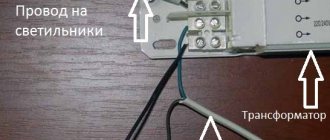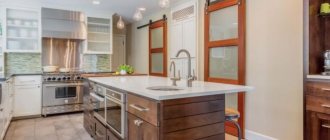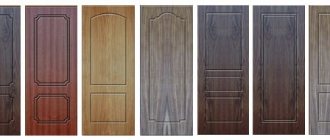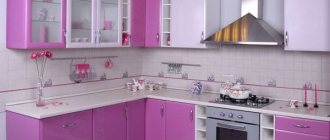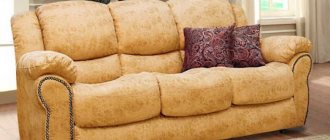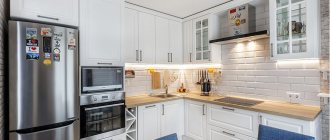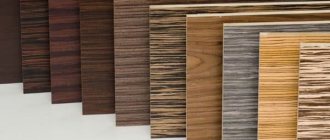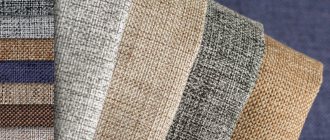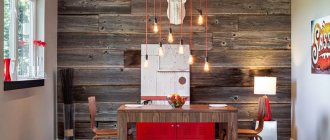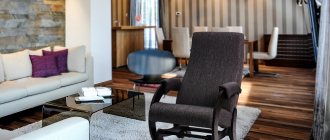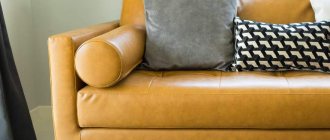The main criterion when choosing kitchen furniture (besides design) is its ability to withstand frequent cleaning and regular contact with hot steam, water, and grease. How long the set will retain its original appearance, and whether it will be easy to care for, depends on the finishing of the facades. Kitchens with enamel coating are considered one of the best solutions in terms of durability.
Enamel kitchens
Kitchens made of MDF with enamel appeared on the furniture market relatively recently, but have already become popular among consumers. They are manufactured using a unique technology that allows us to produce stylish, durable, inexpensive kitchen furniture.
Such furniture structures are made from MDF - a high-quality material that surpasses the previously common chipboard in its characteristics. The finishing of MDF facades is made of enamel, thanks to which the cabinets acquire a unique design.
The following types of enamel coating are used:
- glossy;
- matte;
- metallic;
- chameleon.
The use of this manufacturing technology provides wide design possibilities. The shape of the facades can be any - smooth, rounded, wavy. You can order a small pattern or an individual design to be applied to the facades.
Kinds
The division into types is carried out due to the composition of the paint and the type of surface obtained as a result of applying the layer. Created by a British designer in 1990, chalk paint had an original composition and was sold under the Chalk Paint brand. The recipe for this composition has not yet been revealed, so there are many copies on the market made from a variety of components. All paints are water-based, and the additives present in them give the chalk compositions their corresponding names.
Resin paints contain resins of natural or synthetic origin. The mineral species contain silicates.
Milk paints have casein as an additional component, while oil paints contain linseed oil. Any of these paints can be used for artistic painting on glass, metal or wood, the main thing is to choose the appropriate option.
Ready-made chalk compositions are available in jars or cans. The most famous today is a Finnish manufacturer that produces a wide range of paint and varnish products, including slate paint. The coating formed by chalk paint can have a surface of different textures: smooth, suitable for drawing, and lumpy, with a relief.
Swedish or Finnish paints, which form a smooth or structured surface, belong to different types, and differ in some components that impart certain properties to the applied layer. The basis of textured or slate paint is acrylic, silicone or latex (rubber) emulsion.
To impart magnetic properties to the slate surface, small metal particles are added to the latex emulsion. They are what give the paint its magnetic properties. Magnetic paint adheres well to any materials, and the resulting surface is a good help in educational activities for children.
Emulsions that create a slate effect on the surface are usually dark colors: black, gray, metallic, dark green, burgundy and brown. This is necessary so that the chalk pattern is visible on the surface. A colorless base is also available, which can be given any shade by adding color to the container or painting a colored surface.
To decorate individual objects and paint walls, pearlescent paint is often used. White color is most often used to finish the ceiling surface. Whitewashing the ceiling can be done either with ready-made compounds or prepared at home. For materials exposed to heat, special heat-resistant or fire-resistant compounds are used.
In order for the applied design to stay on the surface for as long as possible, the decorated object is sent to the oven for firing. The possibility of prolonged temperature exposure is possible due to the high heat resistance of chalk compositions. These include stained glass paints used for painting on glass or ceramics.
Manufacturing technology
Kitchens with enamel facades are manufactured in stages. The basis for them is MDF boards with a thickness of 16 to 25 mm. Panels of required shapes and sizes are made from slabs. After this, a foam filler is applied to the surface - a special material that allows air to be removed from it.
After drying, excess filler is removed from the surface and sanded, preparing for painting. Then it is coated with an insulator, dried and sanded again, after which a layer of primer is applied to it. Waterproof varnish can be used as a primer, which does not allow the panels to absorb moisture and thereby extends the service life of the furniture being manufactured. When the primer dries, the surface is sanded again.
When the slabs are completely prepared, they proceed to applying an enamel coating to them. The dye is applied in layers. When the painted surface becomes dry, it is varnished and then thoroughly polished.
A similar technology is used in car painting. Its use not only ensures high quality and durability of the enamel layer, but also makes it possible to choose the surface texture and create various unique effects on it, for example, “vintage”.
How to Use Chalk Paint
When people ask me how to use chalk paint correctly, I always have a hard time answering.
I realize I'm expected to give detailed instructions, but painting with chalk paint is so easy that the only instructions are to open the can, dip a clean brush into it, and start painting! It doesn’t matter what kind of furniture you need to repaint - MDF, chipboard, laminated chipboard or a Soviet glossy polished cabinet. The instructions remain the same - just open the can, dip the brush and start painting
However, in this article I have tried to collect the most common questions I receive about how to repaint furniture with chalk paint.
Do I need to remove the clearcoat or previous paint before repainting? No no need. Chalk paint is suitable for repainting most surfaces without prior preparation - sanding or priming. Why do I say “for the majority”? Because sometimes it happens that for better quality repainting you need to use, for example, a primer. Those. You can repaint it this way (the paint will fall off), but if the surface is very old or was covered with drying oil, oil compounds, or it is not clear what it was coated with, then stains may appear through the paint. This often happens when repainting kitchens, for example. In cases like this, I recommend using a stain-blocking primer. This will save you from unnecessary work later.
Should furniture be sanded before repainting? No no need. Chalk paint has increased adhesion to the surface. It is applied with a roller, brush, sponge and even fingers directly to the surface. In exceptional cases - for example, the furniture has recently been coated with a fresh coat of wax - you can lightly go over it in a circular motion with a sanding block. But there is no need to peel off the top layer, just lightly “dust” the surface.
How to prepare furniture for repainting with chalk paints? The only thing that really needs to be done is to clean the furniture properly. If you are working with old furniture (especially if you bought it and don’t know where and how it was kept), then use a solution of soda and water to clean it. If the furniture has an unpleasant odor, sprinkle baking soda in corners and surfaces and leave it for a day; it absorbs odors perfectly. If the furniture is not too old, it is enough to wash it with water and let the surfaces dry naturally. Before repainting furniture, I always recommend degreasing the surface. This can be done with a simple degreaser, which is sold in construction and hardware stores.
What brushes should I use for chalk paint? When using chalk paint, choose any brushes and rollers that are suitable for water-based paints. Soft synthetic, natural bristles are always a great choice. In the case of rollers, simple rollers with natural fur (short pile) or flock rollers are suitable.
Do I need to thin chalk paint with water? No, the brush does not need to be wetted with water, and the paint does not need to be diluted with water, as we are used to doing when painting with watercolors or gouache. The work begins with a dry brush, which you simply need to dip into the jar. However, to create special decorative effects (glaze, for example), you can use water. It is not prohibited. Our paint is quite thick, which is necessary for a number of artistic techniques. If you need a more fluid paint, you can dilute the paint slightly by adding water to the jar itself (a teaspoon at a time) and stir the paint.
Is it possible to mix chalk paints with each other? Of course you can. You can create new colors by mixing paints with each other. You can mix paints directly on furniture to create special decorative effects.
How to protect repainted furniture? Depending on how the furniture is intended to be used, wax or varnish can be used as a finishing coat. Wax highlights the matte velvet finish of chalk paint, while varnish provides greater protection. For wet rooms and kitchens, I recommend using varnish. For furniture in rooms, I prefer to use wax.
How to use chalk paints? To summarize, the instructions are as simple as possible:
- Clean the surface: wash, degrease
- Open a can of paint
- Dip the brush/roll the paint into the tray (if painting with a roller) and start painting.
If you have any questions about how to properly use chalk paint, write to us and we will answer!
Some interesting facts
- The enamel coating can be applied to the surface of MDF in 4-8 layers. The quality of manufacturing and operational characteristics of facades depend on their quantity. The more layers are applied, the more durable and wear-resistant the finished furniture will be.
- If desired, a kitchen with enamel facades can be repainted in a different color, significantly extending its service life.
- Belarusian kitchens made of MDF with enamel, combining excellent quality with an affordable price, are especially popular on the furniture market.
Chalk paints - characteristics
There are many types of chalk paints on the market, they differ from each other mainly in additives. All products of this type consist of chalk and water (in varying proportions). In addition, they may include:
- resins of synthetic or vegetable origin;
- silicates;
- casein;
- linseed oil.
Depending on the additives, resin paints, mineral paints, milk paints, oil paints and the like are distinguished.
When considering these options, it is difficult to separate the best and worst quality because it all depends on whether they are used properly and in accordance with their intended purpose. For example, for furniture that hasn't been used much, medium quality paint works well. However, already in the kitchen and bathroom, the coating must be resistant to moisture and variable temperatures.
A completely different type of paint will also be needed to cover varnished or varnished hardwood surfaces.
Coatings for decorating fabrics and upholstery will require another type of chalk paint.
Common features of all chalk compositions:
- good adhesion;
- dullness;
- fast drying time;
- environmental friendliness;
- do not cause allergies;
- simple preparation of the substrate.
Advantages of kitchens with enamel facades
- durability, practicality in use;
- ability to withstand high temperatures;
- hygiene, ease of care;
- presentable appearance;
- environmental Safety;
- a large number of color solutions, the ability to implement any design ideas;
- maintainability.
Enamel kitchens are distinguished by high quality workmanship and a long service life. The durable enamel coating can easily withstand high humidity and high temperatures. It does not absorb water or odors, making it ideal for use in kitchens.
High-quality enamel coating does not fade in direct sunlight and retains its original appearance for a long time. It is easy to care for. To do this, it is not necessary to buy special preparations; you can use ordinary detergents.
A unique advantage of a kitchen with enamel facades with glossy surfaces is the ability to visually increase the space. This type of furniture is ideal for small kitchen areas.
The technique of applying enamel allows not only to create unique facades, but also to treat the surface of open shelves, bases and hoods, and decorative elements of furniture. This feature significantly increases the possibilities for creating exclusive designs.
Kinds
The main criterion that determines the characteristics of paintwork materials is the composition, namely: the type of filler and base. Conventionally, all paints for furniture are divided into water-soluble and insoluble. When working with the former, there is no question of what to use to wipe off the substance at the application stage - such compositions can be easily diluted with water and dry quickly without releasing toxins. This group also includes modern highly adhesive brands with a binder based on polymer resins, which after drying form a thin, vapor-permeable, but water-resistant film. Transparent paints include stain, wax, and various impregnations.
Compositions based on organic solvents are represented by oil, polyurethane and alkyd enamels. Their characteristics are far from ideal (the paint dries slowly, smells unpleasant and is most often flammable), but in terms of cheapness and water resistance they win. In particular, this type of paint is recommended to be chosen when using furniture in conditions of high humidity or outdoors.
Depending on the composition of the filler and purpose, the following are distinguished:
Acrylic paints. They are recognized as the safest and most accessible, and are actively used in children's institutions. The scope of their application is limited only by washability - painted coatings need frequent updating. Innovative highly adhesive chalk paints and their analogues with the addition of casein, linseed oil, resins, silicates. After drying they form a beautiful matte finish. Such brands allow high-quality painting of furniture made of chipboard, laminated boards or plastic; their only disadvantage is their high cost. Traditional oil paints. Apply outdoors or in a well-ventilated area and dry for at least 3-4 days. Alkyd-urethane enamels. Forms shiny coatings that are resistant to most external influences
Requires careful handling due to the release of toxins during drying. More often used in production than in everyday life. Expensive latex and silicone water-based compositions
Ideal for furniture that is frequently exposed to moisture. Paints based on polyurethane resins. Used for painting washable furniture surfaces.
Purpose of furniture wax, advice on the correct use of the composition A separate group is represented by specialized products: compositions for restoring leather based on natural waxes, leather paints with the addition of synthetic resins, powder mixtures based on polyesters, epoxy-polyester mixtures. Such brands have a narrow scope of application and are more often used when serious repairs are necessary. The method of their application and compatibility with other coatings are specified in advance.
Acrylic
Cretaceous
Oily
Alkyd-urethane
Latex
Based on polyurethane resins
Disadvantages of kitchens with enamel facades
Along with a large number of advantages, enamel kitchens also have some minor disadvantages. The main one is the low resistance of the enamel coating to mechanical stress. A strong impact may cause the enamel to crack or chip.
If you decide to purchase cabinets with a glossy enamel coating, keep in mind that you will have to wash them often, since the glossy surface is quite easily soiled and gets dirty quickly, fingerprints, grease stains, and stains remain on it.
The above-mentioned shortcomings can be compensated for by caring for kitchen furniture and using mild detergents to care for it. Grease and dirt are easily washed off the enamel surface, so the process of washing cabinets like this does not take much time.
Kitchens made of MDF with enamel are more expensive than kitchens finished with plastic or PVC film, but the higher cost is more than offset by the excellent performance characteristics of this cabinet furniture. They are popular among people who value practicality, safety, and original design.
Can we get to work?
We've sorted out the choice of materials, now let's move on to changing the old furniture. For clarity, we chose two different surfaces: a laminated chipboard cabinet and an MFD shelf.
We will share the easiest and fastest way to color them. Even a beginner can handle this.
First, let's take the necessary tools, namely:
- Several brushes (It is better to buy not the cheapest ones, since there are times when they fall off. This will not have the best effect on the coloring composition)
- Roller
- Masking tape
- Priming
- Sanding cloths
We also took:
- Gray acrylic paint (The most common option, so we’ll focus on it)
- White acrylic
Remember! The lighter the surface, the more difficult it is to paint. This is a painstaking and complex process that requires the application of many layers. If light paint is not necessary for the interior, then it is better to take a different color. This will make it easier for you
task.
- Oil paint for wood
- Varnish
The entire handmade transformation process is divided into two stages:
